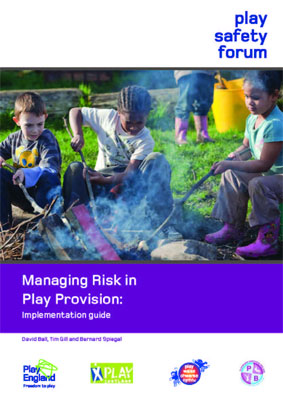|
|
RESOURCES - PLAY SAFETY FORUM |
|

|
Managing Risk in Play Provision: Implementation guide 2012
CLICK
HERE FOR THIS PUBLICATION |
|
Robin Sutcliffe, Chair of the Play Safety Forum said: "Children need and choose exciting places to play, which inevitably means managing situations that are inherently risky. This publication recognises this and gives guidance to providers about how this can be reconciled with a natural desire for children’s safety." Judith Hackitt, Chair of HSE said: "Play – and particularly play outdoors – teaches young people how to deal with risk. Without this awareness and learning they are ill equipped to deal with adult life. Outdoor play and learning is an important part of our children’s education. HSE endorses the proportionate advice in the guide. We should all make sure that needless health and safety excuses do not get in the way of activities. Of course take sensible and reasonable precautions, but let young people play." |
|

|
Risk-Benefit Assessment Form The Risk-Benefit Assessment Form is an easy-to-use tool to support play providers to balance the benefits of an activity with any inherent risk, taking into account the risks while recognising the benefits to children and young people of challenging play experiences. |
|
The Risk-Benefit Assessment (RBA) Form is available in two formats: as a blank form, and as a hypothetical worked example based on a tree swing. It was commissioned and developed by the Play Safety Forum, and is co-authored by Professor David Ball, Tim Gill and Bernard Spiegal. It is based on Managing Risk in Play Provision: Implementation guide. Judith Hackitt, Chair of HSE said: ‘HSE endorses the proportionate advice in the RBA Form. We should all make sure that needless health and safety excuses do not get in the way of activities. Of course take sensible and reasonable precautions, but let young people play.’ Download Risk-Benefit Assessment Form – Worked Example Download Risk-Benefit Assessment Form – blank form The RBA Form is published by Play Scotland in partnership with Play England, Play Wales and PlayBoard Northern Ireland. It was sponsored by, and the copyright belongs to: Play Scotland; Play England: Play Wales and PlayBoard Northern Ireland. |
|

|
Managing risk in play provision: A position statement Managing risk position statement (2002) is produced by the Play Safety Forum to support the work of those involved in play provision of any kind, for example: play areas, playgrounds, adventure playgrounds, play centres and holiday playschemes. These include local authorities, voluntary organisations, play equipment manufacturers and inspection agencies. Children’s Play and Leisure: promoting a balanced approach |

|
The Health and Safety Executive (HSE) and the Play Safety Forum have published a joint high-level statement to promote a balanced approach to managing risk in children’s play – Children’s Play and Leisure – promoting a balanced approach. The statement emphasises that when providing play opportunities, the goal is not to eliminate risk, but to weigh up the risks and the benefits – no child will learn about risk if they are wrapped in cotton wool.
(ABW note - only the first page of this document is published to the PSF website, page 2 shows that children are allowed to die as part of the balanced approach to managing risk at play) |